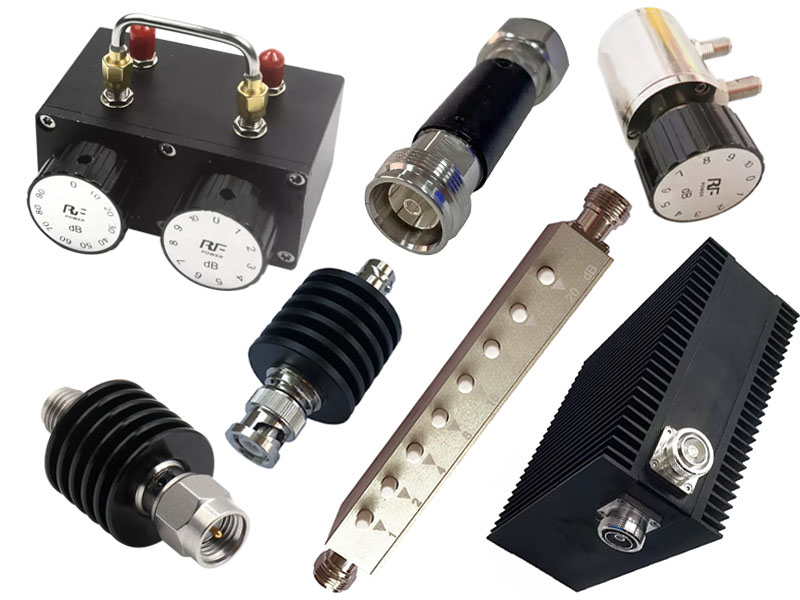-
We’re On Call 24/7 : +8613538296050
-
E-mail : anna@rohoconnector.com
We’re On Call 24/7 : +8613538296050
E-mail : anna@rohoconnector.com
In the bustling world of radio frequency (RF) and microwave engineering, where signals dance at gigahertz speeds, controlling signal levels isn't just desirable – it's essential. Enter the often unsung hero: the RF Attenuator. These passive components act like precise valves, deliberately reducing the power level of an RF signal without significantly distorting its waveform. Let's break down how they are classified and what makes each type unique.
Why Do We Need Attenuators?
Imagine a few common scenarios:
Protecting Sensitive Receivers: A powerful incoming signal could overload and damage your expensive spectrum analyzer or receiver front-end. An attenuator acts as a buffer.
Signal Level Matching: Different parts of a system (amplifiers, mixers, antennas) often require specific input power levels for optimal performance. Attenuators fine-tune these levels.
Improving Impedance Matching: They can help minimize signal reflections (poor VSWR) between mismatched components.
Isolation: Providing isolation between stages in a circuit to prevent unwanted feedback or oscillation.
Test & Measurement: Calibrating equipment, setting precise power levels for device under test (DUT) characterization, or simulating signal path losses.
Classifying RF Attenuators: Structure and Control
The primary classification hinges on how the attenuation value is set and changed:
The Workhorse: Provides a single, unchangeable value of attenuation (e.g., 3dB, 10dB, 20dB).
Construction: Typically built using precision resistive networks (pi-network or T-network configurations) within a coaxial housing or as surface-mount components. Chip attenuators are very common on PCBs.
Key Characteristics:
Simplicity & Reliability: No moving parts.
High Accuracy & Stability: Excellent performance over frequency and temperature.
Excellent VSWR: Designed for minimal signal reflection.
Wide Bandwidth: Can operate effectively over very broad frequency ranges.
High Power Handling: Available in versions handling watts to kilowatts (often waveguide-based for very high power).
Applications: Signal level setting, impedance matching pads, receiver protection, test fixture loss compensation.
Adjustable Control: Allows the attenuation level to be changed continuously or in steps during operation.
Sub-Types:
Mechanically Variable:
How: Uses a moving contact (wiper) on a resistive element (like a film or card) or a moving vane in a waveguide. Adjusted manually via a knob or screw.
Characteristics: Simpler construction, good for manual bench adjustment. Bandwidth and VSWR can vary with setting. Accuracy is generally lower than fixed types.
Voltage Variable Attenuators (VVAs) / Electronically Variable Attenuators (EVAs):
How: Employs active components whose resistance changes with an applied control voltage. Common technologies include:
PIN Diodes: The most widespread. A DC control current/voltage changes the diode's RF resistance.
FETs (GaAs, pHEMT, CMOS): Used as voltage-variable resistors.
MMIC (Monolithic Microwave Integrated Circuit): Integrates the attenuator circuit (often FET-based) onto a single chip for compactness.
Characteristics: Very fast switching speeds (microseconds to nanoseconds), compact size (especially MMIC), enables remote/automated control. Drawbacks include limited power handling, potential for distortion at high signal levels, and need for a control voltage/current.
Digitally Programmable Attenuators (DPAs):
How: Provides attenuation in discrete steps controlled by a digital input (parallel address lines or serial interfaces like SPI/I2C). Internally, they use switched resistive networks or FET switches.
Characteristics: Precise, repeatable digital control, fast settling time (though usually slower than pure VVAs), excellent for automated test equipment (ATE) and calibration systems. Step size (e.g., 0.5dB, 1dB) and resolution are key specs.
Applications: Automatic Gain Control (AGC) loops, system leveling, remote test systems, electronic warfare (ECM), programmable test benches.

Key Characteristics Beyond Type (What to Look For)
When selecting any RF attenuator, these parameters are critical:
Attenuation Value / Range: The dB loss it provides (fixed) or the min/max range it can achieve (variable/programmable).
Accuracy: How close the actual attenuation is to the specified value (e.g., ±0.5 dB).
Frequency Range (Bandwidth): The range of frequencies over which the attenuator meets its specifications. Fixed attenuators often have the widest bandwidth.
Impedance: Almost always 50 Ohms or 75 Ohms (video/cable systems). Must match the system impedance.
VSWR / Return Loss: Measures how well the attenuator matches the system impedance. Lower VSWR (e.g., 1.2:1) or higher Return Loss (e.g., >18 dB) means less signal reflection and better performance. Fixed attenuators excel here.
Power Handling (CW & Peak): The maximum average (Continuous Wave - CW) and peak (pulsed) power the attenuator can safely dissipate without damage or performance degradation. Crucially depends on heat dissipation capability.
Connectors: Type (SMA, N, 2.92mm, etc.) and gender. Must match your cables/interfaces.
Temperature Stability: How much the attenuation value drifts with changes in ambient temperature (e.g., ±0.001 dB/°C).
Switching Speed (for VVAs/DPAs): How fast the attenuation level changes to a new value after a control input change.
Distortion (Linearity): Especially important for VVAs/EVAs at high signal levels. Measured by IP3 (Third-Order Intercept Point) or P1dB (1-dB Compression Point).
Choosing the Right Tool for the Job
Need ultimate accuracy, stability, and power handling for a set level? Fixed Attenuator is your best bet.
Manually adjusting levels on the bench? A Mechanical Variable Attenuator is simple and effective.
Require fast, remote, or automated control? Look to Voltage Variable (VVA) or Digitally Programmable (DPA) attenuators.
Building high-volume integrated circuits? MMIC Attenuators offer compact, integrated solutions.